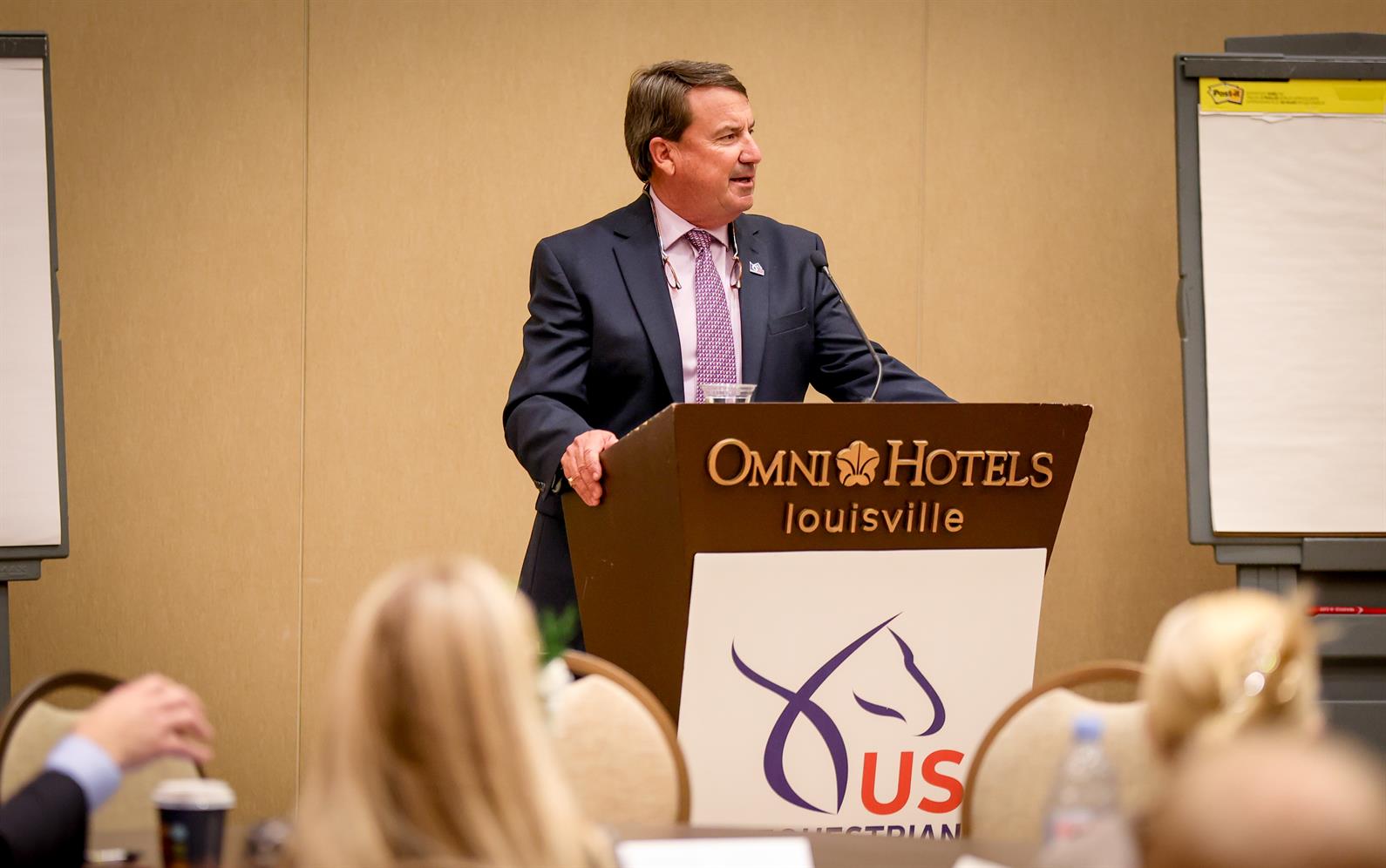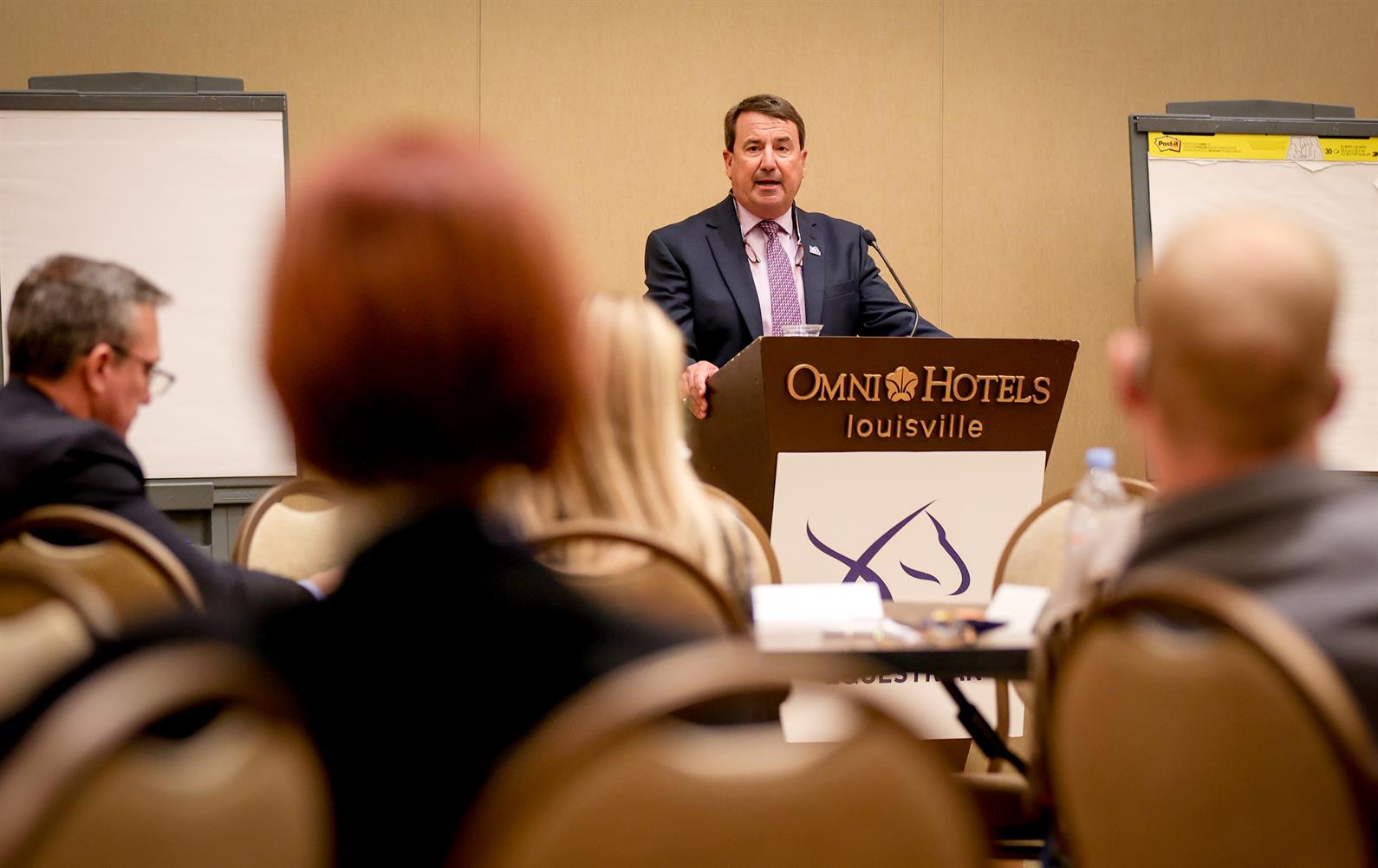Lexington, Ky. - David O'Connor, US Equestrian Chief of Sport, reviewed social license and its effect on equestrian sport during the 2024 US Equestrian Annual Meeting on Jan. 13 in Louisville, Ky. O’Connor was joined by Lisa Lazarus, CEO of the Horseracing Integrity and Safety Authority (HISA), who shared the new reality of horseracing in the United States and how change required a shift in the industry’s culture. O’Connor concluded the workshop by emphasizing the importance of being leaders for the betterment of horses and equestrian sport.
Social License to Operate
O’Connor began the workshop by summarizing social license. “A social license basically rests with the public,” said O’Connor. “It is an acceptance of your activity.” He added that the public wants assurance that an organization is taking horse welfare seriously, in perception and practice (credibility), building long-term relationships (trust) as the pathway to ongoing consent (license) for the activity to continue.”
He explained how social license to operate is an unwritten social contract between the public and an industry or community. O’Connor noted that industries and sports are focusing on protecting their social license and equestrian sport is more vulnerable to negative public opinion because it involves the use of an animal.

(Matt Turer/US Equestrian)
O’Connor continued that all equestrian activities are being put in the spotlight and society doesn’t distinguish between different equestrian activities. He added that the public will prioritize emotion over evidence in deciding whether to grant social license or not. With the public having cellphones, O’Connor pointed out that anyone can be a journalist, and they are capable of capturing moments both in and out of context.
"A lot of times the public doesn’t come in with a negative attitude,” said O’Connor. “Only through an image, social media, or something like that can their opinion be turned when they didn’t start with a negative opinion.”
O’Connor noted why social license is important, detailing examples of public outcry following 29 horse deaths at Santa Anita racetrack in 2019 and horseback riding being removed from modern pentathlon after an incident at the Tokyo 2020 Olympic Games.
“We have dealt with it in the Olympic sports quite a bit. You are told to change, or you are going to get changed,” said O’Connor. “[And when] you are going to get changed, it will be by an organization that doesn’t know as much about your sport as you do.”
With the increase in research and knowledge about horse welfare, O’Connor expressed that now is the time for the industry to take an internal look at itself. He reviewed two surveys completed by the Equine Ethics & Wellbeing Commission which included viewpoints from over 14,000 public respondents and almost 28,000 equestrian stakeholders. In terms of welfare standards, 52% of the public thought standards needed improving, while 78% of equestrian stakeholders thought standards needed improving.
O’Connor shared the action steps that Equine Ethics & Wellbeing Commission said all equestrians need to take:
- Not only optimize and prioritize equine welfare because it is the “right thing to do,” but also to be seen to be doing so.
- Understand their responsibility and the impact of their actions, words, and use of images.
- Ensure that they actively engage with and address concerns related to social license.
Experiences with the Horseracing Integrity and Safety Authority (HISA)
Lisa Lazarus previously worked for the FEI and had her first experience with social license to operate when negative public response followed horses testing positive for prohibited substances after the Beijing 2008 Olympic Games. She said the situation led to a review process for anti-doping rules, how labs operated, and what substances should and shouldn’t be allowed.
Fast forward to the present day, and Lazarus is now the CEO of HISA. She gave a brief overview of how HISA came to be following the intense public scrutiny associated with the 2019 horse deaths at Santa Anita racetrack and several 2020 arrests related to a horse doping ring. Senator Mitch McConnell of Kentucky—a state largely impacted by horseracing—and 230 cosponsors created the Horseracing Integrity and Safety Act. It was passed at the end of 2020. Lazarus was hired as the CEO of HISA in February 2022, and her team launched the Racetrack Safety Program in July 2022, which instituted several safety measures and rules at 51 U.S. racetracks and counting. Lazarus noted that the use of riding crop rule—and its effect on purse earnings for violations—was one rule that, although necessary for equine welfare and maintaining horseracing's social license, was not well-received in the industry in the beginning.
“If you want a real change, you have to change the culture,” said Lazarus. “Two years ago, when we first came out with [the crop rule], there was a lot of negativity around it. Now no one talks about it anymore. It is part of the landscape.”
Lazarus noted that HISA has taken several steps over the past two years, beginning with getting approximately 55,000 horses and 32,000 people, including 900 vets, registered with the organization. She said that stakeholders are required to provide data to HISA to help improve safety, though they may do so anonymously.
Jockeys are another group in the horseracing industry that HISA is working to better support, creating programs ranging from concussion protocols to mental health. While the public is more concerned about horse safety, Lazarus noted that the safety of horse and jockey goes hand in hand.
“Research shows that the best way to keep the jockey safe is to keep the horse safe because the risk of a jockey getting injured is substantially tied to the horse,” said Lazarus.
Additionally, Lazarus noted that the Equine Anti-Doping Program was launched in May 2023 with six comprehensive testing labs. The program has tested 60,000 horses in the last six months and prosecuted 60 cases, with the time from test analysis to case hearing taking about 60 days.
“Our program is focused on the clean trainer—the 98% or 99% of trainers who compete within the rules,” said Lazarus. “Our job is to protect them. To make sure that when they put their horse in the starting gate that they are getting the fairest opportunity to win and showcase their horse’s talents.”
In terms of what success looks like for HISA, Lazarus hopes her organization can become old news.
“When you are not talking about us anymore. You are not talking about safety,” said Lazarus. “When all the media reports on is that incredible race or that amazing show jumping competition. It is just accepted and expected that the horses are safe, that they are treated well, and that there are no welfare issues. When we [HISA] are no longer the story.”

(Matt Turer/US Equestrian)
Lazarus concluded by encouraging the horse industry to unite for the betterment of all horse sports.
“We need to stand together to educate the public,” said Lazarus. “I think we need to relentlessly tell the story of how the horse is really at the center of everything that we all do. The respect for the animal is paramount.”
After a brief Q&A with Lazarus, O’Connor closed out the workshop with some final thoughts. Since horse sports are being observed more closely by the public, O’Connor noted that a unified industry voice has a stronger impact on the future of horse sports and unethical practices cannot be tolerated.
“It is time to lead and not follow,” O’Connor said to equestrian stakeholders. “[Change] can’t come from legislation. It can’t come from outside organizations. It has to come from within, which means it has to come from you.”

